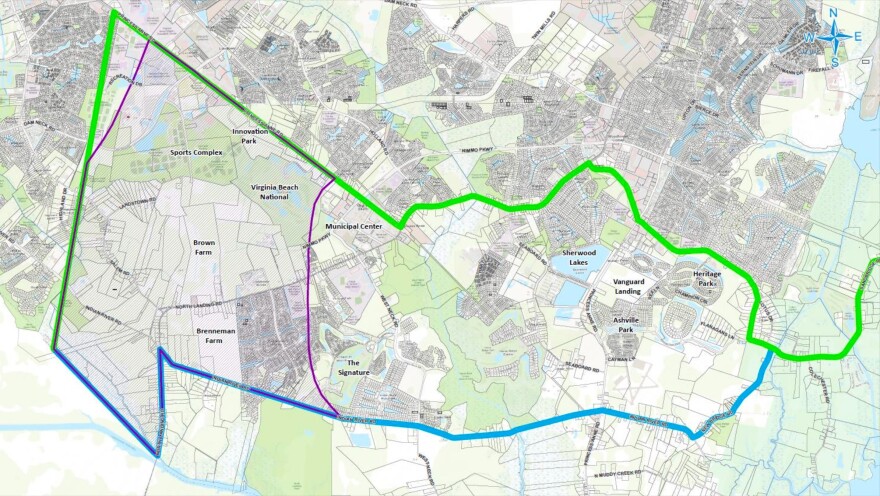Tension is growing below Virginia Beach’s Green Line, an anti-sprawl boundary, as the city considers opening up land there for light industrial use to lure employers.
The city council this month heard ideas for developing land below the line in a zone called the Interfacility Traffic Area, which is located between Naval Air Station Oceana in Virginia Beach and Naval Auxiliary Landing Field Fentress in Chesapeake.
Preliminary proposals include adding sports tourism facilities such as a championship BMX track and light industrial uses, as well as carving out space for a new law enforcement training center within the ITA.
But the most controversial piece is a possible expansion of the existing Innovation Park for new industry on as much as 375 acres of city-owned land.
The ITA is south of the Green Line, which is between the suburbanized northern city and its rural southern reaches. The Green Line is sometimes interpreted as a development stopping point, though it limits and aims to guide growth in conjunction with city policies and plans.
Some council members have said a compromise might be reached to accomplish multiple goals, and there is a need to attract and keep businesses.
On July 8, Mayor Bobby Dyer said Virginia Beach is running out of land.
“And, over time, priorities have changed,” Dyer said.
In January, Deputy City Manager Amanda Jarratt told the City Council there are 4,237 acres of industrial land in the city, but less than 3 percent is undeveloped and for sale.
At the time, City Manager Patrick Duhaney said expanding light industrial uses into the ITA would provide “some relief.” He also said there would be significant infrastructure costs.
Estimates for roads to support extending Innovation Park into the ITA are $5 million for an initial expansion and $25 million for a larger additional phase.
A committee that advises the city about the ITA voted in April that light industrial uses in the area or below the Green Line go against the city’s comprehensive plan and “other publicly vetted documents.”
Diana Hicks, chairperson of the Transition Area/Interfacility Traffic Area Citizens Advisory Committee, said the city should focus on redeveloping above the Green Line where infrastructure exists.
“This includes light industrial uses that require infrastructure and transportation routes,” Hicks said.
City Councilmember Barbara Henley, whose district includes the ITA, reiterated that light industrial uses there would go against existing plans. She supports implementing the proposal for athletic and recreational uses.
Introduced last year, it would build upon an athletic hub in the Princess Anne Commons area and include baseball, pickleball and cross country. It might cost $161 million to implement in full, but partnerships could lessen public cost.

The ITA has its own plan and restrictions. The area contains a number of properties the city bought to prevent encroachment on the jet base, including some land farmed by leaseholders. Residential development is capped at one unit per 15 acres.
The council had asked whether options for different proposals within ITA could coexist, Duhaney said during a July 8 presentation. Any changes could lead the council to update its plan for the ITA, according to Kathy Warren, the city’s planning director.
The city’s ITA plan aims to include open space, recreation and balance development with conservation.
In 2016, the city conveyed 150 acres to the development authority for a biomedical park, per the plan, but that didn’t take off. The target for the park changed to attract advanced manufacturing. Now, Innovation Park has two businesses, one of which has expanded significantly since it opened there. Fewer than 11 acres remain available in the current Innovation Park.
Interest in expanding into the ITA isn’t new. Two years ago, an economic development prospect known as “Project Wayne” eyed 250 acres, then lowered its ask to 150 acres amid concerns. It didn’t go forward amid heavy public pressure to preserve the Green Line as a development boundary.
Henley said in January some land now under discussion was being farmed.
“If we were to change that for this kind of industry, all we’re doing is changing one industry for another,” Henley said.
She said the area is poorly drained and unsuitable for “a lot of concrete.”
In June, a consultant to the Virginia Beach Development Authority presented a 25-year conceptual plan to expand the Innovation Park’s light industrial uses deeper into the ITA.
Last month, one business in the existing park, Acoustical Sheetmetal Company, announced its third expansion in six years.
“These businesses are going gangbusters and they’re looking for opportunities to expand, and there is very little if any industrially zoned land in Virginia Beach,” said Lisa Murphy, the development authority chairperson.
One VBDA member, Don Horsley, farms soybeans on about 457 acres leased from the city in the area that could become light industrial. In an interview, he declined to discuss the proposal.
The council is expected to discuss the issue again during its Aug. 26 retreat.

